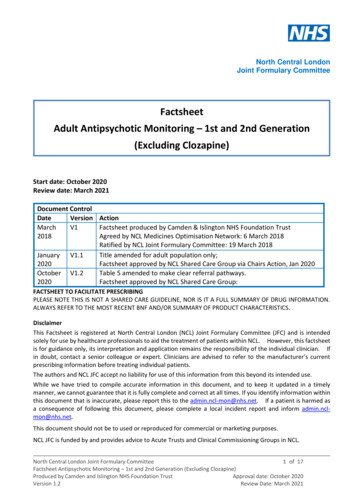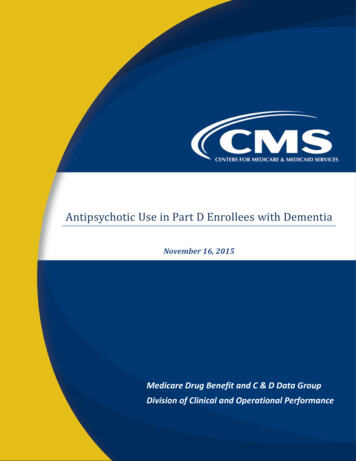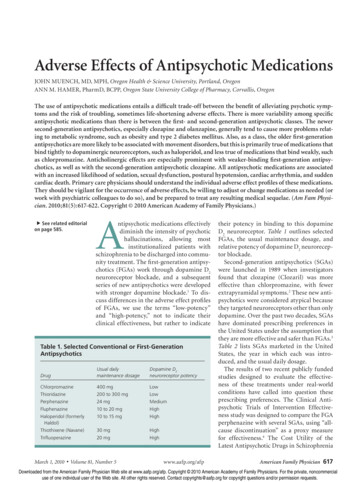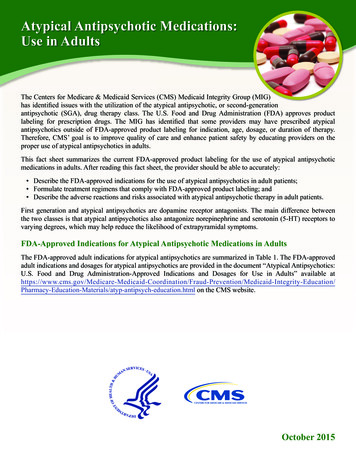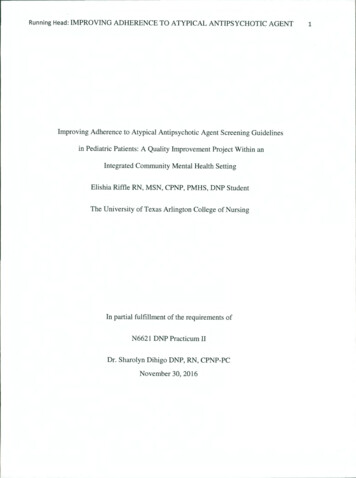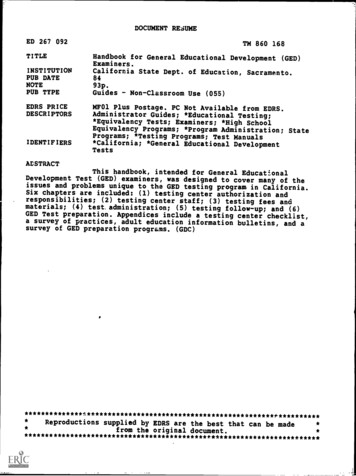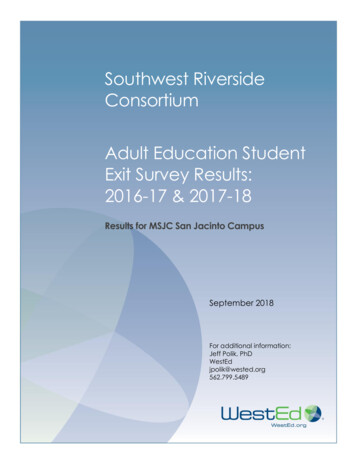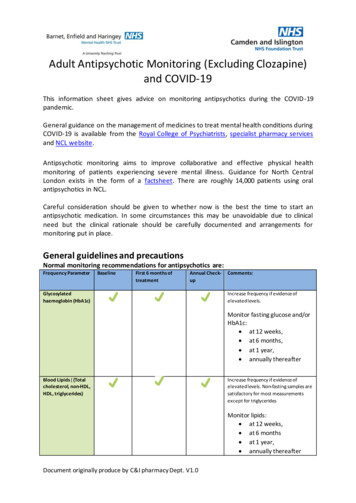
Transcription
Adult Antipsychotic Monitoring (Excluding Clozapine)and COVID-19This information sheet gives advice on monitoring antipsychotics during the COVID-19pandemic.General guidance on the management of medicines to treat mental health conditions duringCOVID-19 is available from the Royal College of Psychiatrists, specialist pharmacy servicesand NCL website.Antipsychotic monitoring aims to improve collaborative and effective physical healthmonitoring of patients experiencing severe mental illness. Guidance for North CentralLondon exists in the form of a factsheet. There are roughly 14,000 patients using oralantipsychotics in NCL.Careful consideration should be given to whether now is the best the time to start anantipsychotic medication. In some circumstances this may be unavoidable due to clinicalneed but the clinical rationale should be carefully documented and arrangements formonitoring put in place.General guidelines and precautionsNormal monitoring recommendations for antipsychotics are:Frequency ParameterBaselineFirst 6 months oftreatmentAnnual CheckupGlycosylatedhaemoglobin (HbA1c)Comments:Increase frequency if evidence ofelevated levels.Monitor fasting glucose and/orHbA1c: at 12 weeks, at 6 months, at 1 year, annually thereafterBlood Lipids ( (Totalcholesterol, non-HDL,HDL, triglycerides)Increase frequency if evidence ofelevated levels. Non-fasting samples aresatisfactory for most measurementsexcept for triglyceridesMonitor lipids: at 12 weeks, at 6 months at 1 year, annually thereafterDocument originally produce by C&I pharmacy Dept. V1.0
FBCRepeat FBC if there are signs andsymptoms of a blood dyscrasiaLFTsRepeat LFTs if there are signs of livertoxicityU&Es &Renal FunctionTFTsBaseline and annual check-up only required for patients with bipolar affective disorder & 6 monthly forrapid-cycling bipolar affective disorder.Quetiapine is associated with small (clinically insignificant decreases in thyroid hormones so annualmonitoring may be advisable)CPKRepeat if there are signs and symptoms ofNMSProlactinConsider repeating level 6 - 12 months after initiation. Amisulpride, Risperidone and theTypical Antipsychotics are associated with hyperprolactinaemia. Repeat if there aresigns of raised prolactin.ECGWhere possible offer all patients an annual ECG, especially where other risk factorsexist. Baseline ECG for all patients especially if there are specific CV risk factors e.g. highBP. During therapy the need for ECG monitoring should be assessed on an individualpatient basis.BP & PulseSee commentsMonitor BP during titration if there are riskfactors for postural hypotension e.g. olderadultsWeight & BMIMonitor weight: weekly for the first 6weeks, at 12 weeks, at 1 year, annually thereafterSmoking StatusMay interact with antipsychotic metabolismSide EffectsIf concerned about side effects an optionaltool to determine if the patient is sufferingfrom excessive side effects fromantipsychotic medication is the Glasgowantipsychotic side effect scale (GASS)Document originally produce by C&I pharmacy Dept. V1.0
During the COVID-19 pandemic, recommendations are: If patients are not in the at-risk category (defined below) then monitoring intervalscan be extended by up to 6 months. However, patients must keep in good physicalhealth and should resume regular monitoring intervals as soon as possible and safeto do so.If patients are in the at-risk category (defined below) then their normal monitoringinterval should be continued. Some measurements such as weight and bloodpressure can be self-monitored. If they live or have had contact with someone whohas symptoms, their monitoring can be delayed for 14 days from the day theirsymptoms started unless there is urgent clinical need.At-risk patients are defined as: Have received less than 6 months treatmentElderly ( 65 years)Renal impairment (Recent unstable renal function (under investigation in last 3months, eGFR 60ml/min)Hepatic impatient (chronic alcohol use, liver disease)High risk of cardiovascular diseaseFor patients with COVID-19 symptoms (new cough and/or fever), recommendations are: If patient does not have symptoms of a cardiovascular event (CVE) ( chest pain,shortness of breath,) new severe extrapyramidal side effects (EPSE), or NeurolepticMalignant Syndrome (NMS) (Fever, diaphoresis, rigidity, confusion, fluctuatingconsciousness, fluctuating blood pressure, tachycardia), then continue antipsychotic.If patient is ‘at-risk’, then patient should wait for 7 days, until temperature subsidesand patient becomes non-infectious, to complete monitoring, unless there is urgentclinical need.If patient has symptoms of CVE, new severe EPSE, or NMS, then withholdantipsychotic and send patient to A&E. The clinician needs to call ahead to advise ofisolation status and seek advice, it may be necessary to call 999.Advise patients to maintain their fluid intake and if needed to consider over-thecounter paracetamol as a first treatment option for fever or pain.PneumoniaAlmost 1 in 5 deaths in schizophrenia are attributable to respiratory disease, with mortalityfrom pneumonia 3.8 times that of the general population (1). Antipsychotics are associatedwith pneumonia (2). Higher doses and antipsychotic polypharmacy confer even greater risk(2). Some studies have also found the risk to be highest in the period immediately followingantipsychotic initiation (3). Other medications that increase the risk of pneumonia includeDocument originally produce by C&I pharmacy Dept. V1.0
inhaled corticosteroids and sedative drugs (4), the latter of which may be particularly likelyto be co-prescribed to those with serious mental illness.Comorbid medical conditions that also increase the risk of pneumonia include dementia,COPD, bronchitis, asthma, cardiovascular disease, heart failure, cerebrovascular disease,stroke, Parkinson’s disease, multiple sclerosis, diabetes, cancer, chronic hepatic or renaldisease and dysphagia (5). Many of these are common comorbidities in people withschizophrenia or may be exacerbated by the side effects of antipsychotic drugs, includingclozapine.Whether there is a causal link between antipsychotics and pneumonia, or independentfactors associated with serious mental illness that increase the risk, or a combination ofboth is unclear. The risk of aspiration may be increased by several factors such as agitation,and by antipsychotics themselves (through hypersalivation, sedation, impairment ofswallowing and cough reflexes or EPSEs). Poor self-care may result in delays in seeking helpfor respiratory symptoms (3), and smoking is well known to increase the risk of acutepneumonia (6).There are currently no data exploring any relationship between antipsychotics orschizophrenia and the risk of contracting COVID-19 or developing severe symptoms to theinfection. In the absence of data it should be assumed that patients taking antipsychotics,particularly where co-morbidities exist, may be at particular risk from COVID-19 andassociated pneumonia.DiabetesAntipsychotics are linked to hyperglycaemia, impaired glucose tolerance and diabeticketoacidosis (7). The risk is further compounded by lifestyle factors (obesity, poor diet andexercise) and a family history.Diabetes, in addition to cerebrovascular and cardiovascular disease, is one of thecomorbidities found in patients who die from or suffer severe symptoms of COVID-19 (8).Patients with COVID-19, in common with other infections, are likely to experiencefluctuations in blood glucose levels. There are as yet no data describing blood glucos e levelsin patients taking antipsychotics who have COVID-19 infection, but it should be assumedthat glucose levels are likely to fluctuate.Further recommendations: Patients who have cerebrovascular disease, cardiovascular disease, diabetes, or whohave had multiple respiratory infections requiring antibiotic treatment in theprevious 6–12 months are assumed to be at higher risk of severe complications ofCOVID-19. Optimise management of these conditions.Patients who smoke should be strongly encouraged to stop. Remember that areduction in smoking will increase some antipsychotics (Olanzapine, Haloperidol,Fluphenazine, and Chlorpromazine) plasma levels and possibly require a doseDocument originally produce by C&I pharmacy Dept. V1.0
reduction. Stopping smoking may also affect other medications. For support on doseadjustment contact the patient’s usual mental health team or if not under a mentalhealth team contact the practice based mental health team or assessment teams.ContactsFor Further support and advice:Barnet, Enfield and HaringeyInpatient and mental health services: Ward Pharmacist or contact pharmacy departmentbeh-tr.stannspharmacy@nhs.net Tel: 0208 702 5435Acute trust: Psychiatric Liaison teams (RFH -Barnet and Chase Farm Sites, NMUH)Camden & IslingtonInpatient and mental health services: Ward Pharmacist or contact pharmacy departmentpharmacy@candi.nhs.uk Tel: 0207 561 4104/3Primary Care:Camden: Camden Primary Care Mental Health Network (C-PCMHN) cim-tr.cpcmh@nhs.netIslington: Practice based mental health team (PBMHT) cim-tr.pbmhs@nhs.netTele: 020 3317 7300/7513Acute trust: Psychiatric Liaison teams (UCLH, RFH, Whittington Health)References1. John A, McGregor J, Jones I, Lee SC, Walters JTR, Owen MJ, et al. Prematuremortality among people with severe mental illness — New evidence from linkedprimary care data. Schizophrenia Research. 2018;2. Kuo CJ, Yang SY, Liao YT, Chen WJ, Lee WC, Shau WY, et al. Second-generationantipsychotic medications and risk of pneumonia in schizophrenia. SchizophreniaBulletin. 2013;3. Dzahini O, Singh N, Taylor D. Antipsychotic drug use and pneumonia: Systematicreview and meta-analysis. Journal of Psychopharmacology. 2018;32(11):1167–81.4. Gau JT, Acharya U, Khan S, Heh V, Mody L, Kao TC. Pharmacotherapy and the risk forcommunity-acquired pneumonia. BMC Geriatrics. 2010;5. Torres A, Peetermans WE, Viegi G, Blasi F. Risk factors for community-acquiredpneumonia in adults in Europe: A literature review. Thorax. 2013;6. Farr BM, Bartlett CLR, Wadsworth J, Miller DL. Risk factors for community-acquirepneumonia diagnosed upon hospital admission. Respiratory Medicine. 2000;7. Taylor DM, Young AH, Barnes TRE. The Maudsley Prescribing Guidelines in Psychiatry13th Edition. Vol. 13, Wiley Blackwell. 2018. 1–854.Document originally produce by C&I pharmacy Dept. V1.0
8. Fang L, Karakiulakis G, Roth M. Are patients with hypertension and diabetes mellitusat increased risk for COVID-19 infection? The Lancet Respiratory Medicine.2020;9. Factsheet Adult Antipsychotic Monitoring – 1st and 2nd Generation (ExcludingClozapine), North Central London Joint Formulary Committee, Start date: hs.uk/wpcontent/uploads/Interface prescribing/FS Antipsychotic Monitoring.pdf10. Positive cardio metabolic health resource, Lester UK Adaptation, 2014 ent originally produce by C&I pharmacy Dept. V1.0
Antipsychotic monitoring aims to improve collaborative and effective physical health monitoring of patients experiencing severe mental illness. . tool to determine if the patient is suffering from excessive side effects from . BMC Geriatrics. 2010; 5. Torres A, Peetermans WE, Viegi G, Blasi F. Risk factors for community-acquired .

